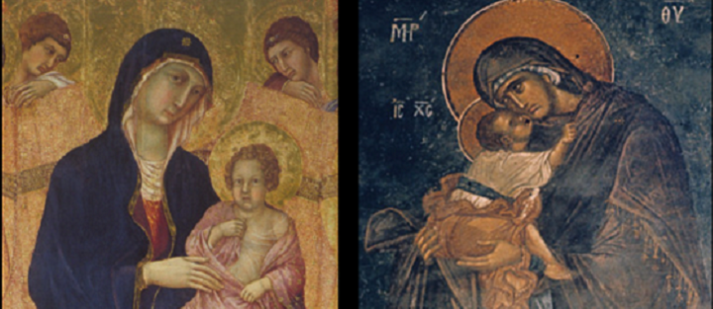About the Project
In collaboration with The Courtauld Institute of Art, the project aims to explore any possible links between Catholic and Orthodox art during the fourteenth century. Whilst comparisons between thirteenth-century Western and Eastern Christian art are plentiful, the fourteenth century is considered as the culmination of the rupture between the two, a rupture that was at first outlined by the Fourth Crusade and the following sack of Constantinople in 1204. Yet documentary evidence informs us that these years are characterised by continuous exchanges between the Orthodox and the Catholic Christian worlds, ranging from embassies, to trade and diplomatic gifts.
Exploring Fourteenth-Century Art Across the Eastern and Western Christian World aims to engage with documentary and visual evidence in order to re-examine traditional views of both Eastern and Western Christian art. It proposes a loose understanding of the fourteenth century that includes the end of the thirteenth and the beginning of the fifteenth to offer a more comprehensive contextualisation.
Read about the project on the Courtauld Institute of Art website.
Project Team
Exploring Fourteenth-Century Art Across the Eastern and Western Christian World was created by Livia Lupi, University of York, and Maria Alessia Rossi, Courtauld Institute of Art, London.
Livia studied History of Art at the University of York before obtaining an MA in late medieval French and Italian art from The Courtauld Institute of Art. She returned to York for her PhD, which she obtained in 2016. Her thesis is entitled Rhetoric of Pictorial Place: Fictive Architecture and Persuasion in Altichiero da Zevio's Oratory of St George and Fra Angelico's Nicholas V Chapel, and investigates the relationship between architecture in painting, place, rhetoric and narrative.
Maria Alessia gained her BA History of Art at “La Sapienza”, University of Rome, and her MA in Byzantine art from The Courtauld Institute. She remained at the Courtauld for her PhD, supervised by Dr Anthony Eastmond. Her thesis is entitled Christ's Miracle Cycle between the Byzantine Empire and the Serbian Kingdom (1290-1330) and concerns the development and proliferation of Christ’s Miracle Cycle in fourteenth-century monumental decoration in the Byzantine and Serbian territories.
Events
Forthcoming Events
27 February 2017: Lecture by Dr Donal Cooper (University of Cambridge) at University of York, Breaking with Byzantium: Franciscan Artistic Patronage and Piety and Patronage in Central Italy at the dawn of the Trecento. BS/005 4.30pm
Past Events
2 November 2016: Lecture by Dr Elena Papastavrou (Director of the Ephorate of Antiquities, Pieria, Greece), The Virgin Singing the Magnificat, the Virgin Carrying the Divine Word: Symbolism and Signs between Byzantine and Western Art, Courtauld Institute of Art, 5.30pm
7 July 2016: Exploring the Fourteenth Century Across the Western and Eastern Christian World - Three Sessions at the International Medieval Congress, Leeds
I Monastic Thought in Art and Literature
This session explores possible points of contact between Orthodox and Catholic monasticism and mysticism. Combining history and art history, the session aims to illustrate the political as well as spiritual implications of the Hesychast controversy in the Orthodox world, varying stances towards the West in Serbian hagiographical narratives of St Symeon, and the depiction of Eastern Desert Fathers in Italian art.
II Abundance and Nearness: Communicating with the Viewer
This art-historical session reassesses points of contact between East and West by examining the role of narrative in Serbian and Byzantine depictions of Christ’s Miracle Cycle; by reflecting on the prominence of architectural structures and abundance of architectural ornament in both Eastern and Western painting; and by looking at Byzantine modes of representation in Italian art.
III Transmission, Exchange, Manipulation
This session examines cultural and artistic exchanges between Italy, England and the Eastern Mediterranean. The first paper focuses on miracle-working images in Bologna, reflecting on how a real or fictitious Eastern origin affected the perceived power of miraculous artworks. It also considers the reasons behind a shift in this tendency, which saw images with well-established Western origin ascend to the status of venerated Eastern objects. The second paper examines the iconography of the Coronation of the Virgin, a Western iconography that nonetheless often presents Eastern connotations. It also explores Marian images more broadly, observing how the coming together of Eastern and Western iconographies and stylistic approaches develops into a new type of narrative describing the last days of the Virgin. The last paper of the session explores the transmission of culinary knowledge from the Greco-Arab tradition in fourteenth-century England, highlighting the connection between power, knowledge and cuisine.
15 May 2015: A Severed Bond?, postgraduate workshop at The Courtauld Institute of Art
This event brought together eight postgraduate students working on medieval art history. The speakers presented on a range of artistic media including fresco, panel painting and metalwork in order to challenge traditional interpretations of fourteenth-century art and also elucidate any possible points of artistic contact between the Eastern and Western Christian world. A Severed Bond? was funded by the Research Forum of The Courtauld Institute of Art and the Department of History of Art of the University of York.
A Severed Bond programme (PDF  , 260kb)
, 260kb)
A Severed Bond abstracts (PDF  , 255kb)
, 255kb)

